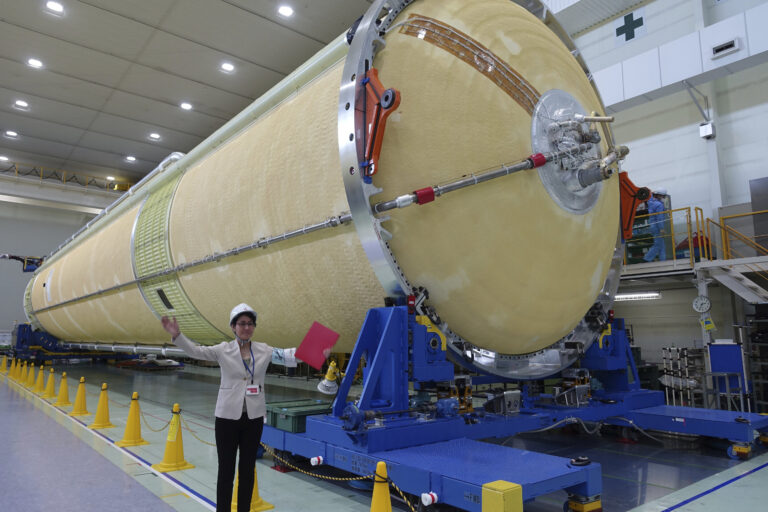A Mitsubishi Heavy Industries employee stands next to the top of the first stage of the H3 rocket at Mitsubishi Heavy Industries Nagoya Aerospace Systems Manufacturing Tobishima Plant in Tobishima, Aichi Prefecture, Thursday, March 21, 2024.Credit:AP Photo/Mari Yamaguchi
× close
A Mitsubishi Heavy Industries employee stands next to the top of the first stage of the H3 rocket at Mitsubishi Heavy Industries Nagoya Aerospace Systems Manufacturing Tobishima Plant in Tobishima, Aichi Prefecture, Thursday, March 21, 2024.Credit:AP Photo/Mari Yamaguchi
Japan's space agency and its prime contractor said Thursday they hope to build a profitable launch business with the new H3 rocket after its successful maiden flight last month in an increasingly competitive market dominated by SpaceX. Ta.
The Japan Aerospace Exploration Agency and Mitsubishi Heavy Industries are developing the H3 as a successor to the current flagship H-2A, which will soon be retired, and the success rate has been 98%, but the high launch cost has made it difficult for the world market. competitiveness was low.
Mitsubishi Heavy Industries' H3 rocket project manager Masayuki Niitsu said the company plans at least six launches a year to meet the rapidly growing demand for communications, observation and security satellites.
“Today, there is a huge demand for rockets in the commercial market and a huge shortage of rockets,” he said at a press conference, standing next to the rocket's second stage. “Currently, SpaceX effectively dominates the market, and I think there are great expectations for our role as an alternative.”
Last year's debut launch failed when the second stage engine failed to ignite, but the H3 rocket reached orbit on February 17 and released two small observation satellites.
Mitsubishi Heavy Industries hopes to eventually take over production and launch of H3 from JAXA and make it commercially viable.
This is the first stage (left) undergoing final preparations for the H3 rocket flight scheduled for later this year, on Thursday, March 21, at Mitsubishi Heavy Industries Nagoya Aerospace Systems Works Tobishima Plant in Tobishima City, Aichi Prefecture. The second stage (right) is shown. 2024.Credit: AP Photo/Mari Yamaguchi
× close
This is the first stage (left) undergoing final preparations for the H3 rocket flight scheduled for later this year, on Thursday, March 21, at Mitsubishi Heavy Industries Nagoya Aerospace Systems Works Tobishima Plant in Tobishima City, Aichi Prefecture. The second stage (right) is shown. 2024.Credit: AP Photo/Mari Yamaguchi
The H3 rocket's first and second stages were shown to the media before being shipped to the Tanegashima Space Center in southwest Japan for final assembly with the main engine and fairing, scheduled for later this week. Ta. Combined, the rocket has a length of 57 meters (187 feet).
To be globally competitive, the H3 is designed to carry a larger payload than the H-2A at about half the launch cost, or about 50 billion yen ($330 million).
However, it is still considered expensive, and Mitsubishi Heavy Industries officials have said they hope to achieve better price competitiveness after about 12 launches.
Niitsu said there are other ways to increase competitiveness, for example by offering flexible launch schedules and better meeting customer needs.
In January, an H-2A rocket successfully placed a reconnaissance satellite into orbit, and a few days later, JAXA's unmanned spacecraft SLIM achieved the world's first “pinpoint” landing on the moon.
© 2024 Associated Press. All rights reserved. This material may not be published, broadcast, rewritten or redistributed without permission.


